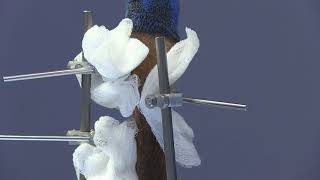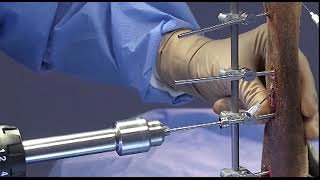
Duraface Fixation Half-Pin
Product Specifications
| Part No. | Compatible ESF Clamp | Functional Thread Length | Overall Length | Recommended Drill Bit | Shaft/Thread Diameter (inch) | Shaft/Thread Diameter |
|---|---|---|---|---|---|---|
| Part No. | Compatible ESF Clamp: Mini, small | Functional Thread Length: 20 mm0.787 in | Overall Length: 95 mm3.74 in | Recommended Drill Bit: 2.0 mm0.079 in | Shaft/Thread Diameter (inch): – | Shaft/Thread Diameter (mm): 2.5 mm | 2.5 mm0.079 in |
| Part No. | Compatible ESF Clamp: Small | Functional Thread Length: 25 mm0.984 in | Overall Length: 100 mm3.937 in | Recommended Drill Bit: 2.3 mm0.079 in | Shaft/Thread Diameter (inch): 1/8" | 1/8" | Shaft/Thread Diameter (mm): 3.2 mm | 3.2 mm0.118 in |
| Part No. | Compatible ESF Clamp: Small | Functional Thread Length: 31 mm1.22 in | Overall Length: 150 mm5.906 in | Recommended Drill Bit: 2.3 mm0.079 in | Shaft/Thread Diameter (inch): 1/8" | 1/8" | Shaft/Thread Diameter (mm): 3.2 mm | 3.2 mm0.118 in |
| Part No. | Compatible ESF Clamp: Small | Functional Thread Length: 28 mm1.102 in | Overall Length: 110 mm4.331 in | Recommended Drill Bit: 2.7 mm0.079 in | Shaft/Thread Diameter (inch): 9/64" | 9/64" | Shaft/Thread Diameter (mm): 3.5 mm | 3.5 mm0.118 in |
| Part No. | Compatible ESF Clamp: Small | Functional Thread Length: 50 mm1.969 in | Overall Length: 150 mm5.906 in | Recommended Drill Bit: 2.7 mm0.079 in | Shaft/Thread Diameter (inch): 9/64" | 9/64" | Shaft/Thread Diameter (mm): 3.5 mm | 3.5 mm0.118 in |
| Part No. | Compatible ESF Clamp: Small, large | Functional Thread Length: 31 mm1.22 in | Overall Length: 115 mm4.528 in | Recommended Drill Bit: 3.1 mm0.118 in | Shaft/Thread Diameter (inch): 5/32" | 5/32" | Shaft/Thread Diameter (mm): 4.0 mm | 4.0 mm0.157 in |
| Part No. | Compatible ESF Clamp: Small, large | Functional Thread Length: 50 mm1.969 in | Overall Length: 150 mm5.906 in | Recommended Drill Bit: 3.1 mm0.118 in | Shaft/Thread Diameter (inch): 5/32" | 5/32" | Shaft/Thread Diameter (mm): 4.0 mm | 4.0 mm0.157 in |
| Part No. | Compatible ESF Clamp: Large | Functional Thread Length: 35 mm1.378 in | Overall Length: 130 mm5.118 in | Recommended Drill Bit: 3.5 mm0.118 in | Shaft/Thread Diameter (inch): 11/64" | 11/64" | Shaft/Thread Diameter (mm): 4.3 mm | 4.3 mm0.157 in |
| Part No. | Compatible ESF Clamp: Large | Functional Thread Length: 54 mm2.126 in | Overall Length: 175 mm6.89 in | Recommended Drill Bit: 3.5 mm0.118 in | Shaft/Thread Diameter (inch): 11/64" | 11/64" | Shaft/Thread Diameter (mm): 4.3 mm | 4.3 mm0.157 in |
| Part No. | Compatible ESF Clamp: Large | Functional Thread Length: 38 mm1.496 in | Overall Length: 150 mm5.906 in | Recommended Drill Bit: 3.9 mm0.118 in | Shaft/Thread Diameter (inch): 3/16" | 3/16" | Shaft/Thread Diameter (mm): 4.8 mm | 4.8 mm0.157 in |
| Part No. | Compatible ESF Clamp: Large | Functional Thread Length: 57 mm2.244 in | Overall Length: 200 mm7.874 in | Recommended Drill Bit: 3.9 mm0.118 in | Shaft/Thread Diameter (inch): 3/16" | 3/16" | Shaft/Thread Diameter (mm): 4.8 mm | 4.8 mm0.157 in |
Learn
The Learn section is a product-specific resource for veterinary surgeons and veterinary staff offering a variety of videos, image galleries, and quick tips on the use of IMEX products. To view additional educational content, visit our Learning Center.
First Major Improvement in ESF Pin Technology
IMEX Duraface half-pins demonstrate a 55% average increase in stiffness and a 3.7 fold increase in cyclic fatigue life compared to current positive-profile pins without an increase in cost. These mechanical improvements can...
Read moreFAQs
-
Will I need to purchase different drill bits to properly pre-drill for Duraface half-pins?
No. A key design feature of these pins was to increase stiffness without changing the pin tract diameter in the bone. As such, the same drill bits used to pre-drill IMEX Interface and Centerface fixation pins are compatible with Duraface half-pins.
-
If Duraface pins are mechanically superior to positive-profile Interface pins and use the same drill bits and sleeves while not costing more, is there any reason I should continue using positive-profile half-pins?
There is no reason not to make the switch. The only negative is past history and experience. For example, technicians and nurses preparing surgery packs, without training on “new” pins may continue to consider shaft diameter as the “pin” size and not look at actual bone engagement diameters. This may lead to pack or ordering errors. It may be best to make a clean switch and not mingle Interface and Duraface pins in the same pack.
-
Will Duraface half-pins function in any brand of ESF clamp?
The SK ESF clamp from IMEX was designed to function over a greater range of pin diameters than other ESF clamps. The SK ESF clamp was also designed to grip any pin style (smooth, positive-profile, and negative-profile) effectively. Most other ESF clamps have a much smaller range of pin choices. Clamps that have pin diameter ranges compatible with certain Duraface half-pins will hold these pins; however, it is likely the surgeon using non-SK clamps will not have as great a pin diameter choice as with the SK ESF clamp by IMEX. This is also true when standard positive-profile pins are used.
-
Is there a sequence and technique for placement of subsequent pins?
Typically, the third and fourth pins placed into an ESF frame are the two pins on each side and closest to the fracture. This is not mandatory; however, it is easier to verify accuracy of reduction and ensures good pin placement. These pins are placed via liberal release incisions and through pre-drilled holes. Placing the SK clamp over the area of soft tissue release, and using the secondary bolt to secure it in perfect alignment for the desired drill hole and pin position ensures correct targeting and pin placement. Next, the appropriate drill sleeve is passed through the primary pin-gripping bolt to protect the soft tissue as the bone is pre-drilled. One must be careful not to crush the thin-walled drill sleeve by tightening the primary pin-gripping bolt more than just enough to hold the sleeve in position. Pre-drilling is performed through the drill sleeve while exercising care not to exert undue pressure on the drill bit. Excess pressure results in drill bit flexing and a sudden “push through” of the drill bit into the opposite soft tissues as it breaks through the bone. The drill sleeve is then removed and low-speed insertion of the fixator pin is performed. After placing pins three and four, recheck reduction and alignment before placing additional pins. Repeat this procedure for as many additional pins as desired.
-
Do you still have questions?
All of our FAQs are located in one central location for you to find the answers when you need them. If you are unable to answer your question, our support team is just an email or call away at imesdesk@imexvet.com and 903-295-2196.
You Might Also Like
External Skeletal FixationExternal Skeletal Fixation > SK Linear ESF SystemExternal Skeletal Fixation > SK Linear ESF System > ClampsNew ProductsProducts
Clamps Components_Clamps | Rods ESF System Size_Large ESF System Size_Mini ESF System Size_Small External Skeletal Fixation SK Linear ESF System
External Skeletal FixationExternal Skeletal Fixation > SK Linear ESF SystemExternal Skeletal Fixation > SK Linear ESF System > ClampsNew ProductsProducts
Clamps Components_Clamps | Rods ESF System Size_Large ESF System Size_Mini ESF System Size_Small External Skeletal Fixation SK Linear ESF System
External Skeletal FixationExternal Skeletal Fixation > SK Linear ESF SystemExternal Skeletal Fixation > SK Linear ESF System > Connecting RodsNew ProductsProducts
Components_Clamps | Rods Connecting Rods ESF System Size_Large ESF System Size_Small External Skeletal Fixation SK Linear ESF System
External Skeletal FixationExternal Skeletal Fixation > SK Linear ESF SystemExternal Skeletal Fixation > SK Linear ESF System > Connecting RodsNew ProductsProducts
Components_Clamps | Rods Connecting Rods ESF System Size_Small External Skeletal Fixation SK Linear ESF System
External Skeletal FixationExternal Skeletal Fixation > SK Linear ESF SystemExternal Skeletal Fixation > SK Linear ESF System > Connecting RodsNew ProductsProducts
Components_Clamps | Rods Connecting Rods ESF System Size_Mini External Skeletal Fixation SK Linear ESF System
Drill Bits & SleevesExternal Skeletal FixationExternal Skeletal Fixation > SK Linear ESF SystemExternal Skeletal Fixation > SK Linear ESF System > Drill Bits And SleevesExternal Skeletal Fixation>InstrumentationInstrumentationInstrumentation>External FixationNew ProductsProducts
Drill Bits & Sleeves Drill Sleeves ESF System Size_Large ESF System Size_Mini ESF System Size_Small External Skeletal Fixation SK Linear ESF System Tools
LEARN
Using and Storing CrossCut Wedge Osteotomy Guides
Correction of angular limb deformities in small animal patients can be challenging and begins with detailed planning of the correction which often involves a closing wedge ostectomy.
Read moreStabilization of Coxofemoral Luxation Using the Toggle Pin Method
There are a number of popular surgical methods for maintaining reduction of coxofemoral luxations - use of the toggle pin method, ilio-femoral sutures to limit external rotation of the hip,...
Read more











